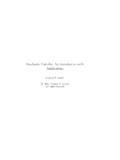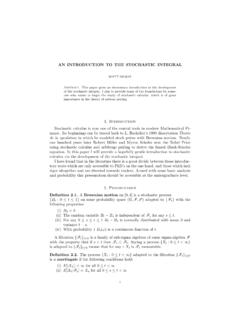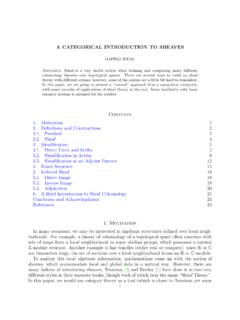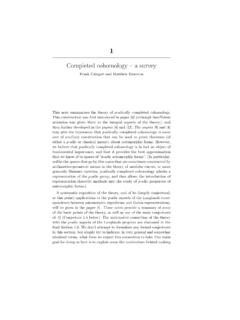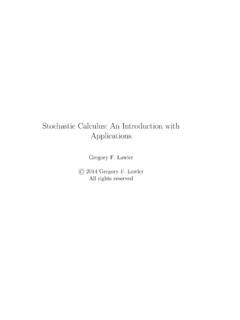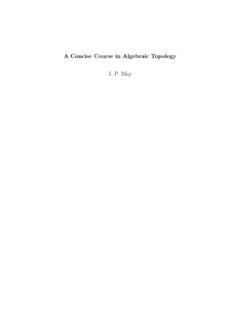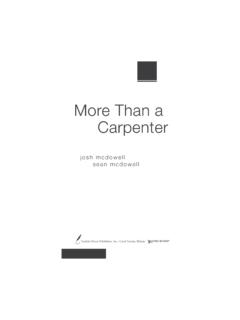Transcription of More is Better
1 more is Betteran investigation of monotonicity assumption in economicsJoohyun ShonAugust 2008 AbstractMonotonicity of preference is assumed in the conventional economictheory to arrive at important conclusions such as more commodities arepreferred to less. However, Gary Becker claims that monotonicity is notnecessary for these conclusions in his bookEconomic Theory[1]. Thispaper investigates Becker s The Conventional Theory1 Economists assume that economic agents (often referred to as the con-sumer in the context of utility maximization) attempt to maximize utility(which means satisfaction in vernacular).Definition a set of all possible spending bundles,c, are elements of this ,U, can be representd as a a preference relation that denotes weak weakly preferred toc2thenc1%c2.
2 In other words,U(c1) U(c2). is a preference relation that denotes strong preference. Ifc1isstrongly preferred toc2thenc1 c2. In other words,U(c1)> U(c2).Definition is a preference relation that denotes indifference. Ifc1%c2andc1-c2are both true then the consumer is said to be indif-ferent. In other words,U(c1) =U(c2)With these definitions, one can now examine the so-called axioms ReflexibilityFor any bundleci,ci%ci1 See Mas-Colellet al.[2] for more complete exposition of microeconomic are many utility functions that are not continuous. I will only consider the contin-uous variety in this CompletenessGiven two bundles, one of the followingis c2 Completeness implies that the consumer can judge between any twoconsumption TransitivityIfc1%c2andc2%c3thenc1%c3 Transitivity makes the completeness axiom applicable to any numberof bundles.
3 The consumer is said to be rational if his or her preference istransitive and (Strict) Monotonicity3 Suppose there are n commodi-ties in bothc1andc2. Monotonicity means that ifc1contains more ofsome or all commodities, but no less of any, thanc2(c1 c2) thenc1% monotonicity means that ifc1contains more of each commoditythanc2(c1> c2) thenc1 c2 Now let us consider the consequences that arise from monotonicity functionUis non-decreasing ifc1 c2impliesU(c1) U(c2). A non-increasing utility function is defined functionUis strictly increasing ifc1> c2impliesU(c1)> U(c2). Astrictly decreasing utility function is defined are monotone if and only ifUis non-decreasingand they are strictly monotone if and only ifUis strictly , we prove that the preference relation%can be represented bya utility function.
4 Then it becomes obvious that preferences are monotoneif and only ifUis functions are real valued functions defined onC. Therefore foranyc1, c2 C,eitherU(c1) U(c2) orU(c1) U(c2) is true (1). If autility function represents the%then (1) implies thatc1%c2or thatc1-c2(2). (2) is true because of now extend this result to anyc C. Supposec1%c2andc2% a utility function represents%thenU(c1) U(c2) andU(c2) U(c3).Therefore,U(c1)%U(c3) which implies thatc1%c3(3). (3) is truebecause of has now been proven that the preference relation%can be rep-resented by a utility function (and also that the consumer needs to berational for the said representation to happen).
5 The second part of the theorem is proven is now clear that the monotonicity assumption implies that theconsumer derives more pleasure from consuming more commodities (ormore precisely, the consumer would not be saddened by the prospectof consuming a greater quantity of commodities). Consider constraints3A more general assumption of nonsatiation can be madein lieuof the monotonicityassumption it is essentially monotonicity defined in the language of limits. There always ex-ists some bundle preferred to the bundle being consumed which may or may not be consumer would face when he or she attempts to maximize his or herutility.
6 Expressed mathematically, the utility maximization problem is:maxx1,..,xnU=U(x1, .. , xn) ni=1pixiwherepiis the price of theith commodity,xi, and I is the consumer s income4. If there were noconstraints, the consumer would continue to consume more commoditiesbecause of monotonicity. And because of monotonicity, the solution to theutility maximization problem ends up at the boundary of the opportunityset (I= ni=1pixi). In other words, the consumer would fully spend hisor her income (whilst the consumer would still prefer to consume beyondhis or her income).Definition indifference curve is the collection of all bundles ofsame utility; in other words,U(x1.)
7 , xn) = U. Where Uis some more technical, and therefore less interesting, consequence ofmonotonicity assumption is that the indifference curves cannot curves cannot two indifference curves,I1andI2 Suppose the said indifference curves intersect and letc1be the bundleat the intersection,c2the bundle onI1andc3the bundle on different indifference curves,U(c2)> U(c3) orU(c2)< U(c3) is true. In turn, eitherc2 c3orc2 c3is the same time,c2is on the same indifference curve withc1andc3on the same curve withc1. That is,c1 c2andc1 c3. Since thepreference relation is assumed to be monotonec1 c2andc1 c3cannothold simultaneously concludes the very brief discussion of conventional economic the-ory.
8 Armed with the knowledge of conventional theory, we can now inves-tigate Becker s utility maximization problem can therefore be solved using constrained optimizationmethods such as the Lagrangian Becker s ClaimInEconomic Theory, Gary Becker claims that monotonicity isimpliedbythe theory. Indeed, he only lists economic rationality as the necessary as-sumption for the mathematical treatment of utility maximization. Beckerproves by contradiction why more is preferred to less of any good were preferred to more , and if the good had anon-negative price, a consumer would increase his utility by re-ducing his demand for that good until he either consumed noneof it or preferred more to less.
9 If a consumer were satiated indifferent between more and less of all goods and if workwere irksome, he would reduce his hours worked and thushis income until either his income (or at least his earnings)vanished or he preferred more of some goods to less; he wouldthen consume only these goods in positive quantities. It is thissense that utility theory implies that more is preferred to lessof all goods actually Becker is not considering the consumer s income as givenbut as the consequence of his or her labor. Therefore the Beckerian utility maximization problem can be stated as:maxx1,..,xnU=U(x1.)
10 , xn) ni=1pixi I=Y+w t, t+l=TwhereYis non-earned income,whourly wage,thours worked,lleisure (hours spent not working) andTtotal time this model, it is clear that the consumer would always operateon the boundary of his or her opportunity set. If an interior bundleis preferred then the consumer would decrease the hours spent workingthereby causing the line ni=1pixi=I=Y+wtto move towards theorigin until it touches the desired point needs to be discussed. We saw that indifference curvesdo not intersect because of the monotonicity assumption does the initialexclusion of monotonicity allow for the possibility of intersecting indiffer-ence curves?
